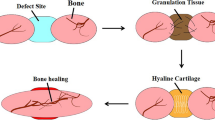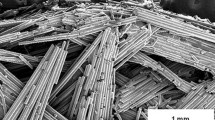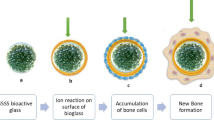Abstract
Purpose
Due to the increasing number of orthopedic injuries occurring each year, there is a critical need for better treatment of improperly healed fractures. To combat this, we have developed a prevascularized, mineralized tissue engineered nanofibrous scaffold for bone regeneration.
Methods
Two stereoisomers of polylactic acid were combined with hydroxyapatite and decellularized vascular tissue to simultaneously entice osteogenic and vascular differentiation of mesenchymal stem cells. These scaffolds were implanted into a rabbit radial defect model for 8 weeks.
Results
The scaffolds were stable throughout the study and micro-CT images taken at 4 and 8 weeks showed considerable remodeling and a large amount of new bone growth in and around the scaffold along with vascular ingrowth, both qualitatively and quantitatively. Bone development in the tissue-engineered scaffold was comparable to an allograft, one of today’s gold standards
Conclusion
This scaffold shows potential to be a clinically useful alternative for treating bone fractures
Lay Summary
While bone fractures involving multiple fracture sites are predominantly caused by severe trauma, they can also be a result of minor accidents such as falls especially within the aging population. We developed a tissue engineered nanofibrous scaffold as an alternative to current treatment of such fractures. Incorporated into our scaffold are cues to promote both bone tissue regeneration as well as the regeneration of vascular tissue which were observed when the scaffolds were implanted in rabbits. These scaffolds show great promise for treatment of bone fractures.








Similar content being viewed by others
References
Soleymanha M, et al. Survey of 2582 cases of acute orthopedic trauma. Trauma monthly. 2014;19(4):e16215. https://doi.org/10.5812/traumamon.16215.
Burge R, Dawson-Hughes B, Solomon DH, Wong JB, King A, Tosteson A. Incidence and Economic Burden of Osteoporosis-Related Fractures in the United States, 2005–2025. J Bone Miner Res. 2007;22:465–75. https://doi.org/10.1359/jbmr.061113.
Liu Y, et al. Hierarchical Structures of Bone and Bioinspired Bone Tissue Engineering. Small. 2016;12(34):4611–32. https://doi.org/10.1002/smll.201600626.
Rodan GA. Introduction to Bone Biology. Bone. 1992;13:3282(09)80003-3. https://doi.org/10.1016/s8756-.
Marsell R, Einhorn TA. The biology of fracture healing. Injury. 2011;42(6):551–5. https://doi.org/10.1016/j.injury.2011.03.031.
Mathew G, Hanson BP. Global burden of trauma: Need for effective fracture therapies. Indian journal of orthopaedics. 2009;43(2):111–6. https://doi.org/10.4103/0019-5413.50843.
Brinker MR, Daniel P, Oʼconnor. The Incidence of Fractures and Dislocations Referred for Orthopaedic Services in a Capitated Population. The Journal of Bone & Joint Surgery. 2004;86(2):290–7. https://doi.org/10.2106/00004623-200402000-00011.
Baldwin P, et al. Autograft, Allograft, and Bone Graft Substitutes. J Orthop Trauma. 2019:1. https://doi.org/10.1097/bot.0000000000001420.
De Long WG, et al. Bone Grafts and Bone Graft Substitutes in Orthopaedic Trauma Surgery. The Journal of Bone and Joint Surgery-American. 2007;89(3):649–58. https://doi.org/10.2106/00004623-200703000-00026.
Dorozhkin SV. Bioceramics of Calcium Orthophosphates. Biomaterials. 2010;31(7):1465–85. https://doi.org/10.1016/j.biomaterials.2009.11.050.
Keating JF, Mcqueen MM. Substitutes For Autologous Bone Graft In Orthopaedic Trauma. J Bone Joint Surg. 2001;83(1):38. https://doi.org/10.1302/0301-620x.83b1.11952.
Howard D, et al. Tissue engineering: strategies, stem cells and scaffolds. J Anat. 2008;213(1):66–72. https://doi.org/10.1111/j.1469-7580.2008.00878.x.
Jun I, et al. Electrospun Fibrous Scaffolds for Tissue Engineering: Viewpoints on Architecture and Fabrication. Int J Mol Sci. 2018;19(3):745. https://doi.org/10.3390/ijms19030745.
Yan X, Yao H, Luo J, Li Z, Wei J. Functionalization of Electrospun Nanofiber for Bone Tissue Engineering. Polymers. 2022;14(14):2940. https://doi.org/10.3390/polym14142940.
Amini AR, et al. Bone tissue engineering: recent advances and challenges. Crit Rev Biomed Eng. 2012;40(5):363–408.
Lopes SV, Collins MN, Reis RL, Oliveira JM, Silva-Correia J. Vascularization Approaches in Tissue Engineering: Recent Developments on Evaluation Tests and Modulation. ACS Appl Bio Mater. 2021;4(4):2941–56. https://doi.org/10.1021/ACSABM.1C00051/ASSET/IMAGES/MEDIUM/MT1C00051_0007.GIF.
Taylor BL, et al. Investigating Processing Techniques for Bovine Gelatin Electrospun Scaffolds for Bone Tissue Regeneration. J Biomed Mater Res B Appl Biomater. 2016;105(5):1131–40. https://doi.org/10.1002/jbm.b.33622.
Cipriano, James. Characterization of a pre-vascularized biomimetic tissue engineered scaffold for bone. Retrieved from https://doi.org/10.7282/T35H7KQX
Andric T, et al. Fabrication and characterization of three-dimensional electrospun scaffolds for bone tissue engineering. Regenerative Engineering and Translational Medicine. 2015;1(1-4):32–41.
Taylor B, et al. Decellularized cortical bone scaffold promotes organized neovascularization in vivo. Tissue Eng A. 2019;25(13-14):964–77.
Wright LD, et al. Fabrication and mechanical characterization of 3D electrospun scaffolds for tissue engineering. Biomed Mater. 2010;5(5):055006.
Patel PP, et al. Mechanical and Biological Evaluation of a Hydroxyapatite Reinforced Scaffold for Bone Regeneration. J Biomed Mater Res A. 2019;107(4):732–41. https://doi.org/10.1002/jbm.a.36588.
Ai X, Pellegrini M, Freeman JW. The Use of Alginate to Inhibit Mineralization for Eventual Vascular Development. Regenerative Engineering and Translational Medicine. 2020:1–10.
Witjas FMR, van den Berg BM, van den Berg CW, Engelse MA, Rabelink TJ. Concise Review: The Endothelial Cell Extracellular Matrix Regulates Tissue Homeostasis and Repair. Stem Cells Transl Med. 2019;8(4):375–82. https://doi.org/10.1002/sctm.18-0155.
Xing Q, et al. Decellularization of Fibroblast Cell Sheets for Natural Extracellular Matrix Scaffold Preparation. Tissue Engineering Part C: Methods. 2015;21(1):77–87. https://doi.org/10.1089/ten.tec.2013.0666.
Sinibaldi K. Harvesting, Storage, and Application of Cortical Allografts. Teton New Media: Current Techniques in Small Animal Surgery, by M. Joseph. Bojrab; 2014. p. 864–5.
Funding
This work was supported by Rutgers TechXpress funding.
Author information
Authors and Affiliations
Corresponding author
Additional information
Publisher’s Note
Springer Nature remains neutral with regard to jurisdictional claims in published maps and institutional affiliations.
Rights and permissions
Springer Nature or its licensor (e.g. a society or other partner) holds exclusive rights to this article under a publishing agreement with the author(s) or other rightsholder(s); author self-archiving of the accepted manuscript version of this article is solely governed by the terms of such publishing agreement and applicable law.
About this article
Cite this article
Buckley, C., Madhavarapu, S., Kamara, Z. et al. In Vivo Evaluation of the Regenerative Capacity of a Nanofibrous, Prevascularized, Load-Bearing Scaffold for Bone Tissue Engineering. Regen. Eng. Transl. Med. 10, 56–67 (2024). https://doi.org/10.1007/s40883-023-00303-3
Received:
Revised:
Accepted:
Published:
Issue Date:
DOI: https://doi.org/10.1007/s40883-023-00303-3




